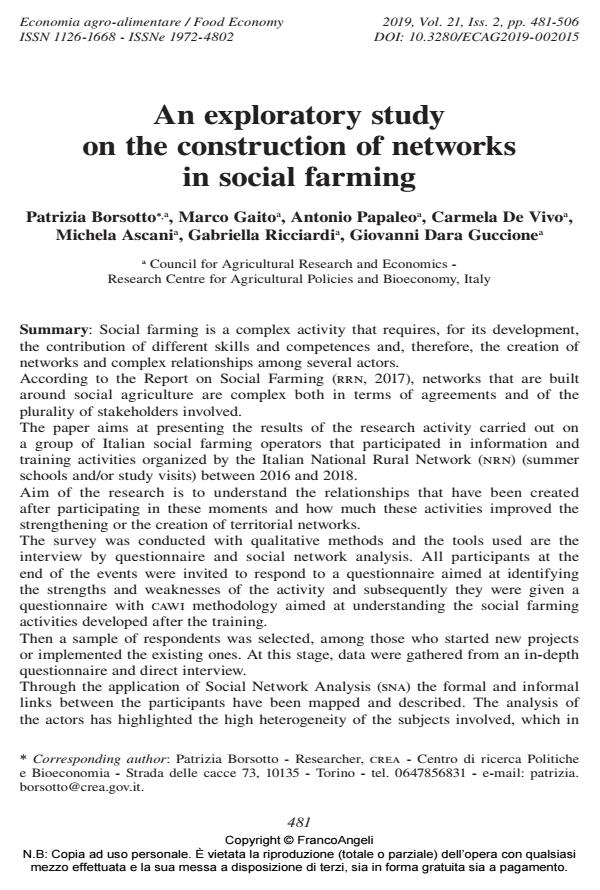An exploratory study on the construction of networks in social farming
Journal title ECONOMIA AGRO-ALIMENTARE
Author/s Patrizia Borsotto, Marco Gaito , Antonio Papaleo, Carmela De Vivo
Publishing Year 2019 Issue 2019/2
Language English Pages 26 P. 481-506 File size 248 KB
DOI 10.3280/ECAG2019-002015
DOI is like a bar code for intellectual property: to have more infomation
click here
Below, you can see the article first page
If you want to buy this article in PDF format, you can do it, following the instructions to buy download credits

FrancoAngeli is member of Publishers International Linking Association, Inc (PILA), a not-for-profit association which run the CrossRef service enabling links to and from online scholarly content.
Social farming is a complex activity that requires, for its development, the contribution of different skills and competences and, therefore, the creation of networks and complex relationships among several actors. According to the Report on Social Farming (rrn, 2017), networks that are built around social agriculture are complex both in terms of agreements and of the plurality of stakeholders involved. The paper aims at presenting the results of the research activity carried out on a group of Italian social farming operators that participated in information and training activities organized by the Italian National Rural Network (nrn) (summer schools and/or study visits) between 2016 and 2018. Aim of the research is to understand the relationships that have been created after participating in these moments and how much these activities improved the strengthening or the creation of territorial networks. The survey was conducted with qualitative methods and the tools used are the interview by questionnaire and social network analysis. All participants at the end of the events were invited to respond to a questionnaire aimed at identifying the strengths and weaknesses of the activity and subsequently they were given a questionnaire with cawi methodology aimed at understanding the social farming activities developed after the training. Then a sample of respondents was selected, among those who started new projects or implemented the existing ones. At this stage, data were gathered from an in-depth questionnaire and direct interview. Through the application of Social Network Analysis (sna) the formal and informal links between the participants have been mapped and described. The analysis of the actors has highlighted the high heterogeneity of the subjects involved, which in most cases is constituted by farmers. The network is not very cohesive due to the lack of links between many actors. However, it is an active and inclusive network characterized by redundant links that may be poorly efficient and an obstacle to its further expansion. Within the network, there are actors who simultaneously hold multiple roles representing multiple interests; the nrn no longer appears as a standalone unit that only performs an "institutional function" but as a social subject.
Keywords: Social farming, social innovation, connective agriculture, network.
Jel codes: O35, D85, L14
- Social innovation as a game changer in agriculture: A literature review Ana Lucia Fernandes da Silva, Jose Antonio Plaza‐Úbeda, Roberta Souza Piao, in Sustainable Development /2024 pp.4160
DOI: 10.1002/sd.2898 - Social farming in high mountain regions: The case of the Aosta Valley in Italy Erika Fazari, Dario Musolino, in Economia agro-alimentare 3/2023 pp.1
DOI: 10.3280/ecag2022oa14053
Patrizia Borsotto, Marco Gaito , Antonio Papaleo, Carmela De Vivo, An exploratory study on the construction of networks in social farming in "ECONOMIA AGRO-ALIMENTARE" 2/2019, pp 481-506, DOI: 10.3280/ECAG2019-002015